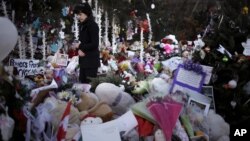As residents of Newtown, Connecticut, bury their dead — six teachers and 20 children killed by a gunman who shot his way into a grade-school classroom — much of the world has been watching.
"People from Japan, Cairo, Egypt, France, Poland... everybody even from all over the United States has been here," says firefighter Anthony Carpenter, standing outside Sandy Hook Elementary School.
But despite the global outpouring of emotion, one question remains universally inescapable: How could 20-year-old Adam Lanza, or anyone, kill children so young?
On the very same day of the attack, parents of students at Chenpeng Village Primary School in Henan province, China, were grappling with the exact same question as 22 of their own children lay wounded in hospital recovery rooms. A knife-wielding 36-year-old man set upon the kids in a frightening replay of knife and cleaver attacks that are only too fresh in the minds of Chinese parents.
According to retired FBI profiler Mary Ellen O'Toole, the choice of young victims can say a lot about the perpetrators.
"These are very young children, and so young that they would not pose a threat to the shooter whatsoever," she says of the Newtown attack. "Easy, also, to control."
Perhaps more disturbingly, O'Toole says Lanza may have known precisely why he chose young victims.
"If you kill children this young, you guarantee that you will get notoriety, and it will be international and you will basically shut down the world for a period of time," she says. "The only way he [Lanza] could have made this worse would be to have [the victims] ... holding puppies and kittens."
While countries such as Argentinea, Azerbaijan, Yemen, Scotland, Norway and Finland are no strangers to targeted killings of young students, war-torn Afghanistan and neighboring Pakistan have witnessed many, the most recent of which — October's Taliban shooting of a 14-year-old Malala Yousufzai — has also drawn international attention.
But O'Toole warns against drawing too many parallels.
"You've got different motives and even though you have the same result, you may have different personalities," she says. "The same results but different personality make-ups of the offender."
According to the American Psychological Association's Dr. Elizabeth Carll, who works with the United Nations on children and trauma, there is also another key difference.
"In situations where a child is living in a war zone, so to speak, it may not be so surprising to experience violence," she says. "It is still very traumatic, and obviously recovery and support is necessary."
But the shock value, she adds, is constant and undifferentiated.
"Certainly the pain and suffering is no different whether it is in China, the Middle East or the U.S.," says Carll.
But in Newtown, Connecticut, there is now only that grief — and the knowledge that no explanation of why will ever be good enough.
"People from Japan, Cairo, Egypt, France, Poland... everybody even from all over the United States has been here," says firefighter Anthony Carpenter, standing outside Sandy Hook Elementary School.
But despite the global outpouring of emotion, one question remains universally inescapable: How could 20-year-old Adam Lanza, or anyone, kill children so young?
On the very same day of the attack, parents of students at Chenpeng Village Primary School in Henan province, China, were grappling with the exact same question as 22 of their own children lay wounded in hospital recovery rooms. A knife-wielding 36-year-old man set upon the kids in a frightening replay of knife and cleaver attacks that are only too fresh in the minds of Chinese parents.
According to retired FBI profiler Mary Ellen O'Toole, the choice of young victims can say a lot about the perpetrators.
"These are very young children, and so young that they would not pose a threat to the shooter whatsoever," she says of the Newtown attack. "Easy, also, to control."
Perhaps more disturbingly, O'Toole says Lanza may have known precisely why he chose young victims.
"If you kill children this young, you guarantee that you will get notoriety, and it will be international and you will basically shut down the world for a period of time," she says. "The only way he [Lanza] could have made this worse would be to have [the victims] ... holding puppies and kittens."
While countries such as Argentinea, Azerbaijan, Yemen, Scotland, Norway and Finland are no strangers to targeted killings of young students, war-torn Afghanistan and neighboring Pakistan have witnessed many, the most recent of which — October's Taliban shooting of a 14-year-old Malala Yousufzai — has also drawn international attention.
But O'Toole warns against drawing too many parallels.
"You've got different motives and even though you have the same result, you may have different personalities," she says. "The same results but different personality make-ups of the offender."
According to the American Psychological Association's Dr. Elizabeth Carll, who works with the United Nations on children and trauma, there is also another key difference.
"In situations where a child is living in a war zone, so to speak, it may not be so surprising to experience violence," she says. "It is still very traumatic, and obviously recovery and support is necessary."
But the shock value, she adds, is constant and undifferentiated.
"Certainly the pain and suffering is no different whether it is in China, the Middle East or the U.S.," says Carll.
But in Newtown, Connecticut, there is now only that grief — and the knowledge that no explanation of why will ever be good enough.









